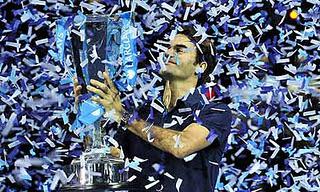
Roger Federer with his 70th winner's trophy
The 2011 ATP season is over [1], and it ended just like last year. RogerFederer dominated the late fall, winning his final seventeen matches, the lastseven of which were against Top 10 ranked opponents (which might be a record),and capturing his record sixth ATP World Tour Finals [2] title. In the process, hedemolished Rafael Nadal in his most lopsided victory against the Spaniard and furthercemented his claim as the greatest player of all time.Butthe end wasn’t at all what the 2011 tennis season was about. Looking back fromthe finish, it’s clear that the climax occurred two-and-a-half months ago inNew York.
US Open Final
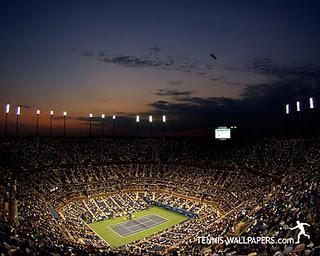
Arthur Ashe Stadium
Lateon a Monday afternoon [3] in early September Novak Djokovic and RafaelNadal, the world’s two best tennis players, took the court at Arthur Ashestadium to contest the U.S. Open Final. It was a rematch of the 2010 Final, butthis year Djokovic was the top seed, winning his way match-by-match through a near-perfect season. Nadal was a definite underdog. As they began theirwarm-up, the sinking sun already cast long shadows across the blue court andits expansive green penumbra. The capacity New York crowd of 25,000, thelargest audience in tennis, buzzed in anticipation.Djokovichad dominated the first eight months of the year. Heading into the U.S. Open Finalhe had remarkably won 63 of his 65 matches, nine titles, including theAustralian Open and Wimbledon, and dominated Nadal, beating him in all five oftheir meetings (all in finals). By what seemed a minor miracle, andconfirmation that he was in the midst of a historic year, he escaped near-certaindefeat in the semi-finals against Roger Federer (click here to see one of the gutsiestand fearless shots you’re ever likely to witness). He looked destined to winthe U.S. Open and consolidate the top ranking he had taken from Nadal atWimbledon. For his part, Nadal was looking to reclaim some of his palpably diminishedaura and end his losing streak to Djokovic. In the process claiming his secondgrand slam title of the year [4], and perhaps steal the number 1 ranking backby the end of the season.
Speakingas a tennis fan, the match was mesmerizing; an apotheosis of power-baselinetennis. Both men played at their peak, as good I think, as they could haveplayed on that surface and that day in front of a huge expectant crowd and millionsof television viewers. They are the two best defenders in tennis and probablythe two most consistent baseline ball-strikers. Those skills resulted in pointafter point of long rallies, of sustained sprinting to all corners of the court,and of pure power hitting. Both men repeatedly retrieved what appeared to besure winners from the other; points ending with each man’s legs and lungsburning. From a purely physical perspective it may have been the most brutaltennis match ever played (see some of the highlights here). By the end Djokovicwas suffering from a back injury and the normally indefatigable Nadal appeared totallyenervated, his body (and maybe his mind) unable to compete any longer. Whatelse was obvious is that point-by-point Djokovic was better. It seemed that hereturned every Nadal serve back at the Spainard’s feet. He won the majority ofthe long rallies. He won the important points.
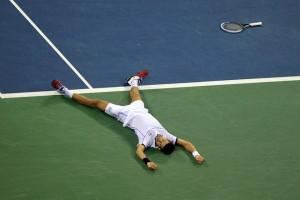
An exhausted Djokovic after his U.S. Open win
Djokovictook the first two sets despite early leads in each by Nadal. With day fadinginto night and the stadium lights taking over, Nadal came back and won the long,intense, captivating third set. After the first game of the fourth set, Djokovic,who just a few minutes earlier was serving for the championship, took a medicaltimeout for a lower back injury. For a moment it appeared that a monumental comeback was in store.But it didn’t happen, Djokovic regrouped and Nadal was spent. After a littlemore than four hours [5] and four unforgiving sets the Serb stood as champion. To borrow a boxing analogy, he took the best punches that Nadal couldthrow and returned his own with interest. He fulfilled the promise of hisseason-long success. He was the best.Post U.S. Open
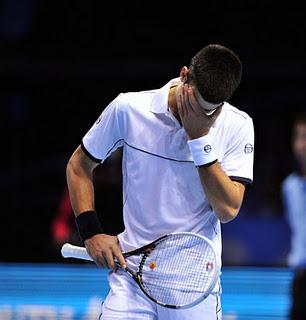
A tired Djokovic at the World Tour Finals
Andthen, after that scintillating victory, the air was let out of the balloon.Djokovic played just ten more matches, going a very average 6-4 over the remainder of the season. At least two,but maybe all four of those losses were at least partially the result of a badback or aching right shoulder. And after his mild exit from the World TourFinals, Djokovic admitted that he was physically and mentally drained. Theseason, and all his success, had taken a toll. He needed time to recuperate. Nadal went just 8-4 after the U.S. Open (andjust 2-4 over his last six matches), including very lopsided losses to Federerand Andy Murray [6].Thepost-U.S. Open fall season often plays like a quiet denouement to the rest of theyear. And given how meekly Djokovic and Nadal played, the two bright lights ofthe season through the U.S. Open, it seemed especially so this year. But thereis more to be gleaned from the late season results.
Thetalk of the first half of the season was how mentally and physicallyunconquerable Djokovic looked. Not only was he winning every match, but he waswearing down his opponents, the opposite of his pre-2011 reputation forfragility. But his former delicateness returned after the U.S. Open. The battle tobecome the best perhaps took more out of Djokovic than was initially apparent.Similarly, Nadal has historically flagged in the second half of the season. He’srenowned for his conditioning and competitiveness and in battles of attrition –his specialty – he almost always came out on top. But all the miles he put intohis legs early in the year tended to catch up with him later. That seemedevident again in 2011. In the World Tour Finals he looked slow and overmatchedin his last two matches [7]. It's also hard not to think that the six losses to Djokovic, all in finals, and all in situations where he had triumphed in the past, took a toll in Nadal's confidence. I'll never doubt the Spaniard's mental fortitude, but he will have to regroup between now and the new year.
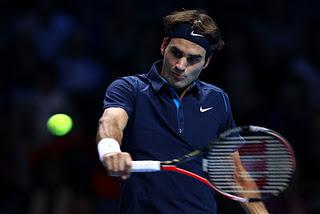
Federer sweeping past Nadal at the World Tour Finals
Contrastthis to Federer, who has flourished at the end of the year. The Swiss is famousfor his graceful movement, seemingly floating above the court, and fluid, easy-lookinggame. He doesn’t put as much stress on his body and expertly manages hisschedule. At age 30 he looked far fresher than either of the much younger men ahead of him inthe rankings [8].And that leads to a larger point. Federer deeply enjoyed his long reign as thegame’s top player. The pressure and expectations of that ranking appealed tohim. In his case, heavy was not thehead that wore the crown. Being on top (or getting there) wore out Djokovic this year. Ithas even seemed to get the better of Nadal, who twice after taking the topranking (2008 and 2010) has had sub-par seasons (2009 and 2011) – for himanyway. It's hard not to conclude that Federer's love of the game and ability to stay fresh year-in and year-out are a big reason why he's been able to amass his amazing record of success.Whoknows what the post-U.S. Open results could mean for next year. Maybe Federer can continue his form intoJanuary’s Australian Open and make another, and somewhat improbable, run at thenumber 1 ranking. Or maybe Djokovic and Nadal will come back in 2012 refreshedand ready for another year battling for grand slam titles. This year will beremembered for Djokovic’s overall dominance, but the last few months hint atsome interesting possibilities for next season. Last year at this time Isuggested that Federer’s late-season success would carry him onto furthersuccess in 2011, and by and large it didn’t. Perhaps it will be the same storynext year. But no one predicted Djokovic’s break-out. Maybe something equallyunpredictable is in store for 2012.
The Year of Novak
Still,late season swoon notwithstanding, Djokovic’s 2011 was a season to remember. Hecaptivating the tennis world by winning his first 41 matches and seven tournaments, became just the sixth man in the Open Era to winthree grand slams in a season, won a record five ATP Masters 1000 tournaments(the level down from the grand slams), and compiled a hard-to-believe 10-1 recordagainst Nadal and Federer. He became the first man since 2003 other than Federer and Nadalto finish the season ranked number 1, and when he took over the topranking after Wimbledon, he was the first man other than the pair to hold theranking at any time since Federer ascended to the top spot at the beginning of2004. By any measure his 2011 stands as one of the best seasons in tennishistory.
The Greatest Season
When I last wrote about tennis, prior to theU.S. Open, commentators were already starting to speak about Djokovic’s seasonin historic terms. Now with the season complete, we can finish thiscomparison and try and place Djokovic’s 2011 in context. Here is a list of(arguably) the seven best seasons since 1980:
Player Year Record PCT. Grand Slam Titles Overall Titles Record vs. Top 10 PCT.
John McEnroe 1984 82-3 0.965 2 13 24-2 0.923
Pete Sampras 1994 77-12 0.865 2 10 13-6 0.684
Roger Federer 2004 74-6 0.925 3 11 18-0 1.000
Roger Federer 2005 81-4 0.953 2 11 14-2 0.875
Roger Federer 2006 92-5 0.948 3 12 19-4 0.826
Rafael Nadal 2010 71-10 0.877 3 7 11-5 0.688
Novak Djokovic 2011 70-6 0.921 3 10 21-4 0.840
Source: atpwprldtour.com and wikipedia.orgOverthe summer some were predicting that Djokovic’s 2011 would go down as thegreatest season ever. But the stats suggest that while it should be considered asone of the best seasons, it is almost certainly less impressive that JohnMcEnroe’s 1984 or Roger Federer’s 2005 and 2006. I think in the longer term itwill be Djokovic’s supplanting of Federer and Nadal at the top of the game thatwill be the most noteworthy result of his very noteworthy 2011.
Ican’t help but observe the glut of dominant seasons since Roger Federer came tothe top of the game. It would be hard to underestimate the example that hisdominance from 2004 through 2007 had on the recent seasons from Nadal (2008,2010) and Djokovic (2011).
---
NOTES:
[1] TheDavis Cup Final, an ITF event, will be played in Seville, Spain next weekend.The favored Spanish team is hosting Argentina.
[2] Formerlyknown as the Masters Cup.
[3] Forthe fourth consecutive year rain had pushed the men’s final from Sunday toMonday. The U.S. Open is the only grand slam tournament that holds the semi-finalsand finals on consecutive days, leaving little wiggle room to adjust forinclement weather late in the tournament. A player revolt this year might leadto the more traditional off day between the semi-finals and finals.
[4] Hewon his record tying sixth French open title in June.
[5] Thepoints were long and hard, but the length of the match was also the result ofthe pace of play. Nadal and Djokovic must surely be the two slowest-playingplayers in the modern game. Compare the Final to the Djokovic-Federer five setsemi-final, which took a half hour less time to play. Federer is perhaps the quickest-playingplayer.
[6] Hewill play at least one and maybe two matches in the upcoming David Cup Final. He’llbe a heavy favorite on his favored clay court surface.
[7] Aterrible loss to Federer and a tired-looking third set against Jo-WilfriedTsonga.
[8]Nadal is 25 and Djokovic is 24.

